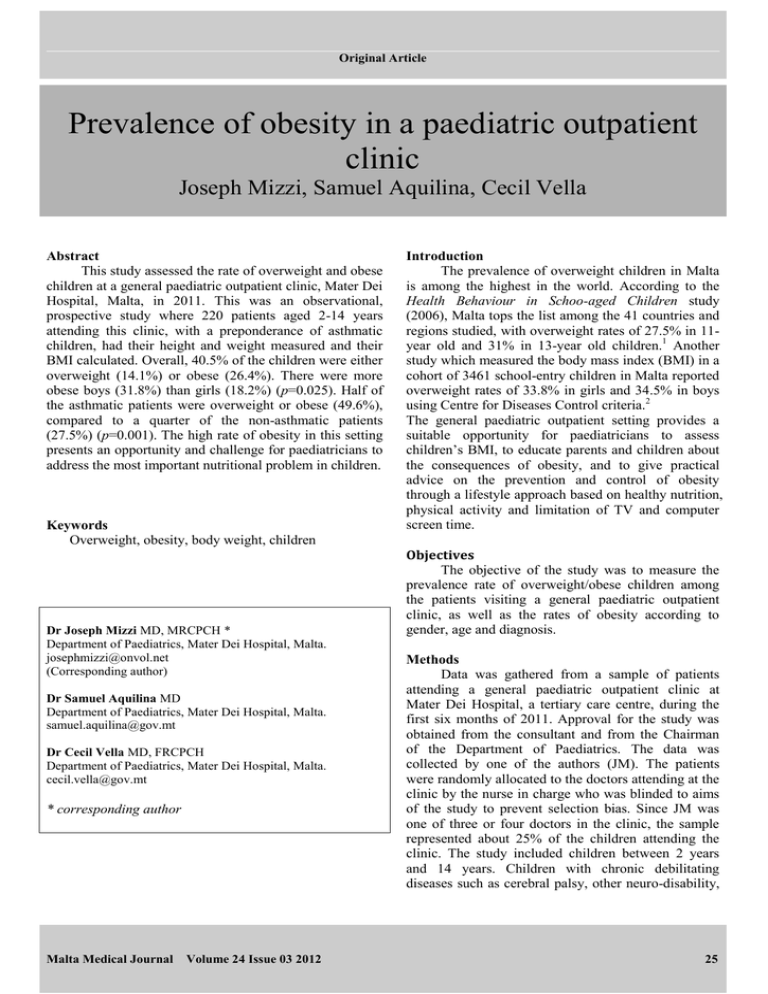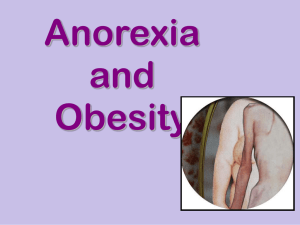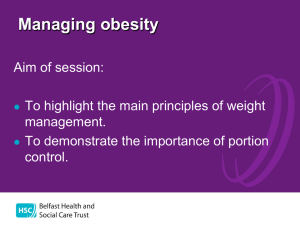Prevalence of obesity in a paediatric outpatient clinic
advertisement

Original Article Prevalence of obesity in a paediatric outpatient clinic Joseph Mizzi, Samuel Aquilina, Cecil Vella Abstract This study assessed the rate of overweight and obese children at a general paediatric outpatient clinic, Mater Dei Hospital, Malta, in 2011. This was an observational, prospective study where 220 patients aged 2-14 years attending this clinic, with a preponderance of asthmatic children, had their height and weight measured and their BMI calculated. Overall, 40.5% of the children were either overweight (14.1%) or obese (26.4%). There were more obese boys (31.8%) than girls (18.2%) (p=0.025). Half of the asthmatic patients were overweight or obese (49.6%), compared to a quarter of the non-asthmatic patients (27.5%) (p=0.001). The high rate of obesity in this setting presents an opportunity and challenge for paediatricians to address the most important nutritional problem in children. Keywords Overweight, obesity, body weight, children Dr Joseph Mizzi MD, MRCPCH * Department of Paediatrics, Mater Dei Hospital, Malta. josephmizzi@onvol.net (Corresponding author) Dr Samuel Aquilina MD Department of Paediatrics, Mater Dei Hospital, Malta. samuel.aquilina@gov.mt Dr Cecil Vella MD, FRCPCH Department of Paediatrics, Mater Dei Hospital, Malta. cecil.vella@gov.mt * corresponding author Malta Medical Journal Volume 24 Issue 03 2012 Introduction The prevalence of overweight children in Malta is among the highest in the world. According to the Health Behaviour in Schoo-aged Children study (2006), Malta tops the list among the 41 countries and regions studied, with overweight rates of 27.5% in 11year old and 31% in 13-year old children.1 Another study which measured the body mass index (BMI) in a cohort of 3461 school-entry children in Malta reported overweight rates of 33.8% in girls and 34.5% in boys using Centre for Diseases Control criteria.2 The general paediatric outpatient setting provides a suitable opportunity for paediatricians to assess children’s BMI, to educate parents and children about the consequences of obesity, and to give practical advice on the prevention and control of obesity through a lifestyle approach based on healthy nutrition, physical activity and limitation of TV and computer screen time. Objectives The objective of the study was to measure the prevalence rate of overweight/obese children among the patients visiting a general paediatric outpatient clinic, as well as the rates of obesity according to gender, age and diagnosis. Methods Data was gathered from a sample of patients attending a general paediatric outpatient clinic at Mater Dei Hospital, a tertiary care centre, during the first six months of 2011. Approval for the study was obtained from the consultant and from the Chairman of the Department of Paediatrics. The data was collected by one of the authors (JM). The patients were randomly allocated to the doctors attending at the clinic by the nurse in charge who was blinded to aims of the study to prevent selection bias. Since JM was one of three or four doctors in the clinic, the sample represented about 25% of the children attending the clinic. The study included children between 2 years and 14 years. Children with chronic debilitating diseases such as cerebral palsy, other neuro-disability, 25 Original Article Down Syndrome and inflammatory bowel disease were excluded. The children’s height was measured using a standardized stadiometer (AE Adam MDW 160M) and they were weighed in light clothing using the same electronic scales. The gender, age and diagnosis and reason for attending the clinic were noted. The BMI and the percentile were calculated online,3 using the measured height in metres, weight in kilograms, and date of birth. The results were tabulated, and each child was categorized as underweight (BMI lower than the 5th percentile); healthy weight (BMI at the 5th to lower than the 85th percentile); overweight (BMI at or above the 85th percentile and lower than the 95th percentile) and obese (BMI at or above the 95th percentile). Chi-squared tests were carried out using an online statistics tool, taking a p value of <0.05 to confirm significance. Underweight (%) Normal (%) Overweight (%) Obese (%) Overweight/Obese (%) Total 3 (1.4) 128 (58.2) 31(14.1) 58 (26.4) 89 (40.5) 220 2–5 1 (1.4) 41 (56.2) 14 (19.2) 17 (23.3) 31 (42.5) 73 6–9 1 (1.4) 47 (63.5) 9 (12.2) 17 (23.0) 26 (35.2) 74 10 – 14 1 (1.4) 40 (54.8) 8 (11.0) 24 (32.9) 32 (43.9) 73 Female 1 (1.1) 55 (62.5) 16 (18.2) 16 (18.2) 32 (36.4) 88 (60) Male 2 (1.5) 73 (55.3) 15 (11.4) 42 (31.8) 57 (43.2) 132 (40) Asthma 2 (1.6) 63 (48.8) 23 (17.8) 41 (31.8) 64 (49.6) 129 (58.6) Other 1 (1.1) 65 (71.4) 8 (8.8) 17 (18.7) 25 (27.5) 91 (41.4) Overall Age (yrs) Gender Diagnosis Table 1: Number (and percentage) of children in different weight categories classified by age, sex and diagnosis. Results The results are summarized in Table 1. Two hundred and twenty children were included in the study, 132 (60%) boys and 88 (40%) girls. One hundred twenty nine (58.6%) children were asthmatic; the other diagnosis are summarized in Table 2. One hundred twenty eight (58.2%) children had a healthy weight; 89 (40.5%) were classified either as overweight (31, 14.1%) or obese (58, 26.4%). Three children were underweight. The rates of overweight/obesity were similar in the different age groups. The higher rate of overweight/obesity observed among boys (57, 43.2%) compared to girls (32, 36.4%) was not statistically significant (p=0.313) (Figure 1). There were more obese boys (42, 31.8%) than girls (16, 18.2%) (p=0.025). Almost half of the asthmatic patients (64, 49.6%) were classified as overweight or obese, compared to just over a quarter of the non-asthmatic patients (25, 27.5%) (p=0.001) (Figure 2). Malta Medical Journal Volume 24 Issue 03 2012 Diagnosis Asthma Coeliac Constipation Epilepsy Gastroenteritis Pneumonia Allergic Rhinitis Familial Mediterranean Fever Urinary tract infection No 129 56.8% 9 7 6 6 6 5 5 Diagnosis Headaches Failure to thrive Henoch Schonlein Purpura Lymphadenopathy Abdominal pain Hypertension Joint pains Miscellaneous No 5 3 3 3 2 2 2 22 5 Table 2: Distribution of patients [n = 220] according to diagnosis 26 Original Article Figure 1: Distribution of boys and girls in different weight categories. Figure 2: Distribution of asthmatics and other patients in different weight categories. Discussion This relatively small study highlights what is already known about the high prevalence of overweight children in our island. The rate of 40.5% overweight/obesity in paediatric out-patients is well above the estimated national rates detailed above. A study in Australia also found a significantly higher rate of obesity in a paediatric outpatient population when compared to the national figure.4 The current study also highlights a higher proportion of overweight and obese boys than girls. This has already been described in previous studies on Maltese children.2, 3 The main limitations of this study are the small size and the bias of the study population. The sample studied was taken from a general paediatric outpatient clinic, which is not representative of all children seen in other specialised clinics, such as neurology and cardiology clinics. Moreover it is not representative of the national childhood population. Therefore, the results cannot be extrapolated to the entire Maltese childhood population or to all children attending Paediatric Outpatient Department. Nevertheless, this study has demonstrated once again the high prevalence of overweight and obesity in Maltese children, on this occasion in those attending a general paediatric outpatient clinic. The study highlights the opportunity and challenge for paediatricians attending these clinics to address this important health issue. Patients suffering from asthma formed a major part of the study subjects, allowing for a comparison between the rate of obesity in asthmatics and non-asthmatic patients. Indeed, almost half of the asthmatics were found to be overweight/obese compared to just over a quarter of nonasthmatic children. In a recent study, Forno et al. showed that obese children had a lower response to inhaled budesonide when compared to normal-weight asthmatics.5 The association between obesity and the poor control of asthma is corroborated by other studies.6,7 Weight control is thus an important factor in the management of moderate to severe asthma. Weight and height measurement should be part of the routine examination of children, and the parents should be alerted if their child is overweight. Many parents have misconceptions about their children’s weight.8 While many consult the paediatrician for what they perceive as a ‘poor appetite’, very few seem to be aware or concerned about their children’s obesity.9 This was highlighted by one child in this study who was referred as a result of a perceived ‘poor appetite’, but in fact had a BMI in the overweight range. Weight control is notoriously difficult to achieve and maintain, even in dedicated obesity clinics. Parental commitment is a crucial factor for success.10,11 Parents of overweight children often complain that their child ‘does not eat anything’. In one instance during this study period, after a thorough discussion with a mother about healthy food choices, she gave her son a packet of sweets on their way out of the clinic. On a more positive note, in another instance, the parents of another child managed to control his weight from the obesity to normal range within a span of two years. The child himself was unaware of the subtle changes implemented by the family, which included healthy food choices, control of portion size, limit on screen time, and increased physical exercise through play and outdoor activities. The obesity epidemic in Malta, especially among children, is a major public health concern and it should be tackled on many fronts. Paediatricians and family doctors have an important role to play. Hospital and community paediatricians, as well as other primary care providers, are well positioned to raise and Malta Medical Journal Volume 24 Issue 03 2012 27 Original Article discuss the issues with parents and children, and to give them specific information on weight control. Good quality information leaflets and a dedicated website in Maltese would be useful tools. A family-focused community-based intervention programme should also be made available to refer the more severe cases. Acknowledgements We would like to acknowledge Prof. Victor Grech (Consultant Paediatrician) and Prof. Simon Attard Montalto (Chairman, Department of Paediatrics) for their help and advice with manuscript preparation. References 1. 2. 3. Currie C, Gabhainn SN, Godeau E, Roberts C, Smith R, et al. editors. Inequalities in young people’s health: HBSC international report from the 2005/2006 Survey [Internet]. WHO Regional Office for Europe, 2003 [cited 2011, July 10]. Available from: http://www.euro.who.int/__data/assets/pdf_file/0005/53852/E9141 6.pdf Grech V, Farrugia Sant’Angelo V. Body mass index estimation in a school-entry aged cohort in Malta. Int J Pediatr Obes. 2009;4(2):126-8. Center for Disease Control and Prevention [Internet]. BMI Percentile Calculator for Child and Teen Metric Version. [cited Malta Medical Journal Volume 24 Issue 03 2012 2011]. Available from: http://apps.nccd.cdc.gov/dnpabmi/Calculator.aspx?Calculator Type=Metric 4. O’Connor J, Youde LS, Allen JR, Baur LA. Obesity and under-nutrition in a tertiary paediatric hospital. J Paediatr Child Health. 2004 May-Jun;40(5-6):299-304. 5. Forno E, Lescher R, Strunk R, Weiss S, Fuhlbrigge A, et al. Decreased response to inhaled steroids in overweight and obese asthmatic children. J Allergy Clin Immunol. 2011 Mar;127(3):741-9. 6. Peters-Golden M, Swern A, Bird SS, Hustad CM, Grant E, et al. Influence of body mass index on the response to asthma controller agents. Eur Respir J. 2006 Mar;27(3):495-503. 7. Bibi H, Shoseyov D, Feigenbaum D, Genis M, Friger M, et al. The relationship between asthma and obesity in children: is it real or a case of over diagnosis? J Asthma. 2004 Jun;41(4):403-10. 8. Wen X, Hui SS. Chinese parents’ perceptions of their children’s weights and their relationship to parenting behaviours. Child Care Health Dev. 2011 May;37(3):343-51. 9. Jones AR, Parkinson KN, Drewett RF, Hyland RM, Pearce MS, Adamson AJ et al. Parental perceptions of weight status in children: the Gateshead Millennium Study. Int J Obes (Lond). 2011 Jul;35(7):953-62. 10. Andrews KR, Silk KS, Eneli IU. Parents as health promoters: a theory of planned behaviour perspective on the prevention of childhood obesity. J Health Commun. 2010 Jan;15(1):95107. 11. Lindsay AC, Sussner KM, Kim J, Gortmaker S. The role of parents in preventing childhood obesity. Future Child. 2006 Spring;16(1):169-86. 28






